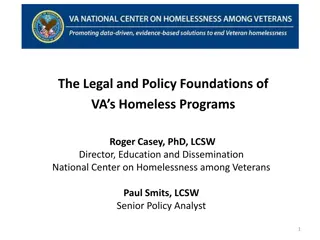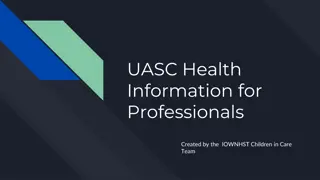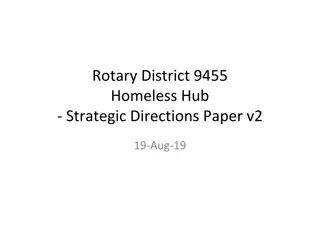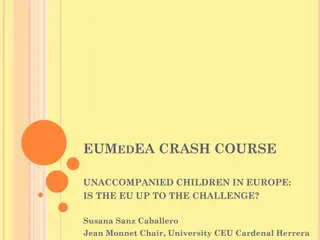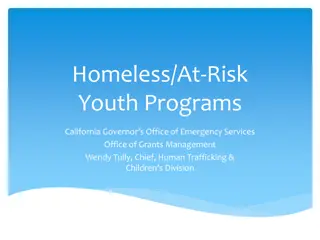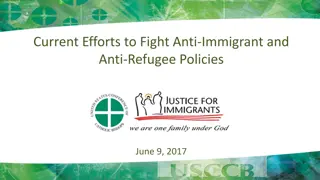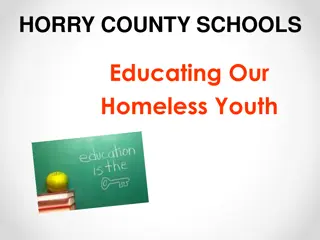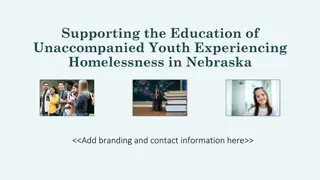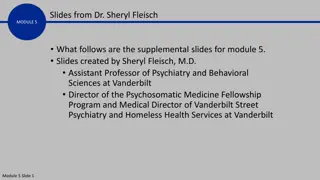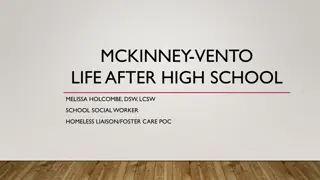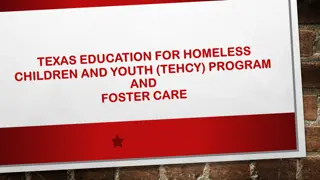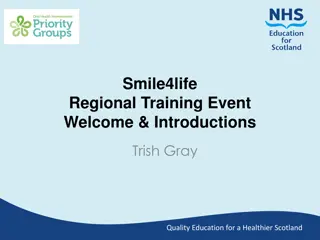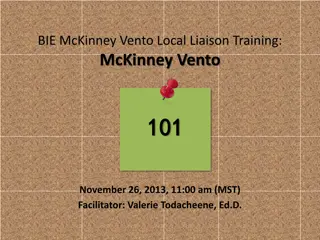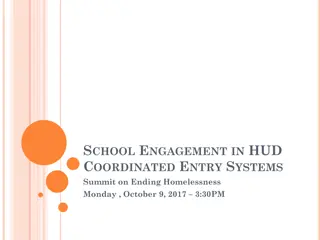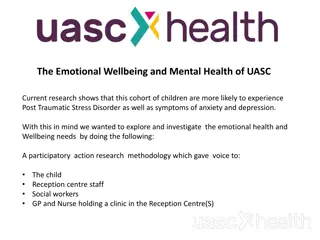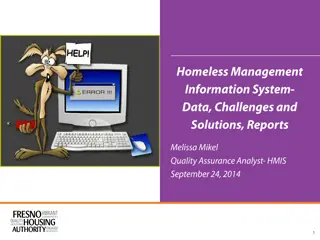Addressing the Needs of Unaccompanied and Homeless Youth in Education
Exploring the challenges and strategies in providing education and services to unaccompanied and homeless youth, delving into the ethical considerations, PEIMS indicators, McKinney-Vento Act provisions, and definitions of unaccompanied and homeless students.
Download Presentation

Please find below an Image/Link to download the presentation.
The content on the website is provided AS IS for your information and personal use only. It may not be sold, licensed, or shared on other websites without obtaining consent from the author.If you encounter any issues during the download, it is possible that the publisher has removed the file from their server.
You are allowed to download the files provided on this website for personal or commercial use, subject to the condition that they are used lawfully. All files are the property of their respective owners.
The content on the website is provided AS IS for your information and personal use only. It may not be sold, licensed, or shared on other websites without obtaining consent from the author.
E N D
Presentation Transcript
Educating Unaccompanied and Homeless Youth David Ray Region 10 ESC
Educating Unaccompanied and Homeless Youth Non-Agenda Spend anytime discussing the moral or ethical pros and cons with regards to providing services to the homeless.
Educating Unaccompanied and Homeless Youth Agenda PEIMS Information Are they homeless? HoLi Checklist 1stTier Services 2ndTier Services Common Concerns
Educating Unaccompanied and Homeless Youth McKinney-Vento Reauthorized in 2002 (NCLB) and 2015 (ESSA) Creates Homeless Liaison Defines Homelessness Main themes: School Stability, School Access, Academic Success, Best-Interest Decision Making Texas Education Code Establishes Broad School Selection
Educating Unaccompanied and Homeless Youth PEIMS Homeless Indicator 0= Not Homeless 1= Sheltered 2= Doubled Up 3= Unsheltered 4= Hotel/Motel
Educating Unaccompanied and Homeless Youth PEIMS Unaccompanied Indicator 3= Homeless and in the physical custody of a parent or guardian for the entire year 4= Homeless and not in the physical custody of a parent or legal guardian at anytime during the school year
Educating Unaccompanied and Homeless Youth Homeless Unaccompanied Students not with legal guardians
Educating Unaccompanied and Homeless Youth Unaccompanied Youth. The term unaccompanied youth includes a youth not in the physical custody of a parent or guardian. This would include youth living in runaway shelters, abandoned buildings, cars, on the streets, or in other inadequate housing and children and youth denied housing by their families (sometimes referred to as throwaway children and youth) (Federal Guidance)
Educating Unaccompanied and Homeless Youth In 1938, Huey, Dewey and Louie are sent to live with Uncle Donald because their father was in the hospital and their mother, Della Duck (Donald s twin sister), could not care for them. Homeless & Unaccompanied
Educating Unaccompanied and Homeless Youth By 1941, the boys had permanently moved in with Donald. However, guardianship transfer was never sought. Students not with legal guardians
Educating Unaccompanied and Homeless Youth In 1987, Donald joined the navy. He made a plan with his Uncle, Scrooge McDuck, to watch the boys while he was away. Students not with legal guardians
Educating Unaccompanied and Homeless Youth Homeless & Unaccompanied
Educating Unaccompanied and Homeless Youth 1 in 10 report being raped 1 in 100 die each year, the vast majority from suicide 75% report at least one parent who abused drugs or alcohol 20-40% were sexually abused in their homes 40-60% were physically abused Many youth have been thrown out because of their sexual orientation (20-40% identify as LGBT) 10% of currently homeless female teenagers are pregnant
Educating Unaccompanied and Homeless Youth Homeless Liaisons parent or guardian (or in the case of an unaccompanied youth, the liaison)
Educating Unaccompanied and Homeless Youth Nutrition Established by letter from USDA Exists as a comparable service Automatic eligibility
Educating Unaccompanied and Homeless Youth Enrollment and Evaluation Immediate enrollment (M-V Act) Enrollment disputes and Immunization Issues are immediately referred to the HoLi (Federal Guidance) Evaluate all students at a regular interval (State Guidance)
Educating Unaccompanied and Homeless Youth provide assistance to the parent or guardian of each homeless child or youth (or, in the case of an unaccompanied youth, the youth) to exercise the right to attend the parent's or guardian's (or youth's) choice of schools (M-V Act)
Educating Unaccompanied and Homeless Youth ENROLLMENT (i) The school selected in accordance with this paragraph shall immediately enroll the homeless child or youth, even if the child or youth is unable to produce records normally required for enrollment, such as previous academic records, medical records, proof of residency, or other documentation. (ii) The enrolling school shall immediately contact the school last attended by the child or youth to obtain relevant academic and other records. (iii) If the child or youth needs to obtain immunizations, or immunization or medical records, the enrolling school shall immediately refer the parent or guardian of the child or youth to the local educational agency liaison designated under paragraph (1)(J)(ii), who shall assist in obtaining necessary immunizations, or immunization or medical records, in accordance with subparagraph (D). (M-V Act)
Educating Unaccompanied and Homeless Youth LEA liaisons can use creative techniques to identify unaccompanied homeless youth while respecting their privacy and dignity, such as administering surveys to peers, using enrollment questionnaires, or providing specific outreach to areas where eligible students who are out of school might congregate. (Federal Guidance) Develop caregiver affidavits, enrollment forms for unaccompanied youth, and other forms to replace typical proof of guardianship. Again, such forms should be carefully crafted so they do not create further barriers or delay enrollment; (Federal Guidance)
Educating Unaccompanied and Homeless Youth Therefore, the LEA must provide the parent, guardian, or unaccompanied youth with a written statement of the school placement decision and the appeal rights. The LEA must refer the unaccompanied youth, parent, or guardian to the LEA liaison, who must expeditiously carry out the dispute resolution process. (Federal Guidance) Parents, guardians, and unaccompanied youth should be able to initiate the dispute resolution process directly at the school they choose, as well as at the district or LEA homeless liaison s office; (Federal Guidance)
Educating Unaccompanied and Homeless Youth (iii) in the case of an unaccompanied youth, ensure that the homeless liaison designated under paragraph (1)(J)(ii) assists in placement or enrollment decisions under this subparagraph, considers the views of such unaccompanied youth, and provides notice to such youth of the right to appeal under subparagraph (E). (iv) in the case of an unaccompanied youth, the homeless liaison shall ensure that the youth is immediately enrolled in school pending resolution of the dispute.
Educating Unaccompanied and Homeless Youth Transportation to the School of Origin At the request of the student or HoLi (M-V Act) Must consider student best interest (Federal Guidance) Other transportation is comparable (Federal Guidance, TEA Letter)
Educating Unaccompanied and Homeless Youth The State and its local educational agencies will adopt policies and practices to ensure that transportation is provided, at the request of the parent or guardian (or in the case of an unaccompanied youth, the liaison), to and from the school of origin, (M-V Act)
Educating Unaccompanied and Homeless Youth (vii) the parent or guardian of a homeless child or youth, and any unaccompanied youth, is fully informed of all transportation services, including transportation to the school of origin, as described in paragraph (1)(J)(iii), and is assisted in accessing transportation to the school that is selected under paragraph (3)(A). (M-V Act)
Educating Unaccompanied and Homeless Youth Parents, guardians, and unaccompanied youth should be informed that they can provide written or oral documentation to support their position; Students should be provided with all services for which they are eligible while disputes are resolved; Written notice should be complete, as brief as possible, simply stated, and provided in a language the parent, guardian, or unaccompanied youth can understand. The notice should include: 1. Contact information for the LEA homeless liaison and State coordinator, with a brief description of their roles; 2. A simple, detachable form that parents, guardians, or unaccompanied youth can complete and turn in to the school to initiate the dispute process. (The school should copy the form and return the copy to the parent, guardian or youth for their records when it is submitted); 3. A step-by-step description of how to dispute the school s decision; 4. Notice of the right to enroll immediately in the school of choice pending resolution of the dispute; 5. Notice that immediate enrollment includes full participation in all school activities; 6. Notice of the right to appeal to the State if the district-level resolution is not satisfactory; and 7. Timelines for resolving district- and State-level appeals.
Educating Unaccompanied and Homeless Youth UIL Homeless students need their school administrator to apply to the UIL for a waiver of residence if the student plans to participate in varsity athletics. Residence rules for athletic varsity eligibility are found in Section 440 (b) and 442 of the Constitution and Contest Rules.
Educating Unaccompanied and Homeless Youth Health/Immunizations Immediate referral to HoLi Age 16 and up can consent to own medical treatment (FC)
Educating Unaccompanied and Homeless Youth Tex. Fam. Code 32.003: Consent to Treatment by Child (a) A child may consent to medical, dental, psychological, and surgical treatment for the child by a licensed physician or dentist if the child: (2) is: (A) 16 years of age or older and resides separate and apart from the child's parents, managing conservator, or guardian, with or without the consent of the parents, managing conservator, or guardian and regardless of the duration of the residence; and (B) managing the child's own financial affairs, regardless of the source of the income;
Educating Unaccompanied and Homeless Youth Grades and Credit Recovery 90% rule has exceptions Encouraged to get creative TXVSN is an option Flexible Schedules (Mobile, AL and Anchorage, AK) Review transcripts to see if credit can be given Award credit for employment
Educating Unaccompanied and Homeless Youth Texas Codes > Education Code > Title 2 > Subtitle E > Chapter 25 > Subchapter C >25.092 (a-1) A student who is in attendance for at least 75 percent but less than 90 percent of the days a class is offered may be given credit for the class if the student completes a plan approved by the school's principal that provides for the student to meet the instructional requirements of the class. A student under the jurisdiction of a court in a criminal or juvenile justice proceeding may not receive credit under this subsection without the consent of the judge presiding over the student's case. (b) The board of trustees of each school district shall appoint one or more attendance committees to hear petitions for class credit by students who are in attendance fewer than the number of days required under Subsection (a) and have not earned class credit under Subsection (a-1). Classroom teachers shall comprise a majority of the membership of the committee. A committee may give class credit to a student because of extenuating circumstances. Each board of trustees shall establish guidelines to determine what constitutes extenuating circumstances and shall adopt policies establishing alternative ways for students to make up work or regain credit lost because of absences. The alternative ways must include at least one option that does not require a student to pay a fee authorized under Section 11.158(a)(15). A certified public school employee may not be assigned additional instructional duties as a result of this section outside of the regular workday unless the employee is compensated for the duties at a reasonable rate of pay.
Educating Unaccompanied and Homeless Youth Truancy and Drop-Out Method for reviewing absences? Which are related to homelessness and which are not? What are the students expectations of themselves?
Educating Unaccompanied and Homeless Youth ARD Meetings and Special Education Legal framework (ESC18) assigns a surrogate Also defines parent broadly An individual acting in the place of a biological or adoptive parent (including a grandparent, stepparent, or other relative) with whom the child lives, or an individual who is legally responsible for the child's welfare
Educating Unaccompanied and Homeless Youth FAFSA and Post-Secondary Education Unaccompanied Homeless students meet the definition of Independent Student Verification can be made by the HoLi (Sample Letter) Youth who are in foster care at any time after age 13 are also considered independent students
Educating Unaccompanied and Homeless Youth Foster Care and CPS Students who run away from Foster Care are considered Homeless Students who are awaiting Foster Care Placement are considered Homeless When do I call CPS? (FC)
Educating Unaccompanied and Homeless Youth SSI, TANF, Medicaid, Housing etc. SSI Student must be disabled Ages 16-18 can apply on their own Food Stamps No age minimum No parent signature required No denial based on lack of address of ID Eligibility is based on household not family Couch Surfing youth are considered their own household
Educating Unaccompanied and Homeless Youth SSI, TANF, Medicaid, Housing etc. TANF Large barriers for Unaccompanied Youth Medicaid Most students would qualify Youth under the age of 21 who are financially eligible but not dependent children (i.e. because they do not live with parents). Financial eligibility levels vary greatly among states, but are often very low. Parental income is not considered if the youth does not live with parents. Housing
Educating Unaccompanied and Homeless Youth David Ray Region 10 ESC







